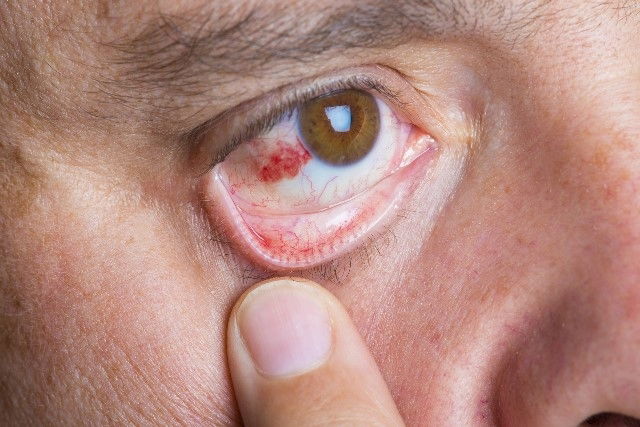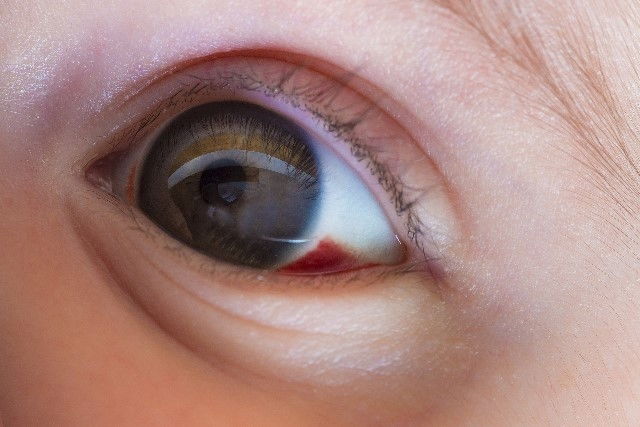A red spot on the eye can occur for many reasons, like irritation from a certain product or a speck, a scratch, or an allergic reaction. It can also be a sign of an eye condition, like episcleritis, for example.
A concerning cause of a red spot on the eyeball is subconjunctival hemorrhage, which is when a blood vessel ruptures from exertion, sneezing, coughing, scratching or direct trauma.
To determine the underlying cause of a red spot on the eye, you should see an ophthalmologist, who can assess you and prescribe treatment as necessary.

Main causes
The most common causes of a red spot on the the eye include:
1. Scratch to the eye
An eye can become irritated to a scratch, which can happen with aggressive itching or if a foreign object falls into the eye. The membrane that lines the eyeballs, the conjunctiva, is fragile and contains blood vessels that can easily rupture.
What to do: To relieve eye irritation, you can apply cold compresses to the affected eye, and use moisturizing eye drops. If the pain is intense and does not approve, or if the spot continues to grow, you should see an ophthalmologist to assess how deep the lesion is.
2. Allergic reaction
An allergic reaction can be triggered by dust, mites, mold or chemical substances (like makeup or shampoo). It can lead to eye redness throughout the entire time or just localized to one spot, and can lead to conjunctivitis.
In addition to a red spot, patients may also notice itching, burning, tearing or a swollen eyelid. Other symptoms, like sneezing and itching, may suggest that an environmental allergy triggered the redness
What to do: You should avoid contact with the trigger, cleanse your eyes with water, and use lubricating or antihistamine eye drops. If symptoms persist for over 2 days, you should see an ophthalmologist for further assessment.
3. Subconjunctival hemorrhage
This condition occurs when a superficial blood vessel in the eye ruptures, leading to a visible bruise.
The most common causes of this type of bleeding are itching or rubbing the eyes, exertion, vomiting, eye or eyelid infections, or eye surgery.
What to do: In most cases, a subconjunctival hemorrhage is not a serious finding an resolves on its own within a few days. You can apply cold compresses to the eyes twice a day and use artificial tears to speed-up recovery and reduce discomfort. If the redness does not improve within a few days, or if it causes pain or vision changes, you should consult an ophthalmologist.

4. Episcleritis
Episcleritis is an inflammation of the layer that lines the cornea, causing a red spot on the eye and. In some cases, a small moveable lump may appear on the eyeball. This is also known as an episcleral nodule.
This a benign condition and the it is not full known yet what triggers it. However, it appears to be associated with autoimmune diseases, rheumatic conditions or infections, like syphilis or herpes.
What to do: Generally, episcleritis resolves on its own in 1 to 2 weeks. Treatment may involve applying cold water compresses on the affected eye and artifical tears. The ophthalmologist may prescribe anti-inflammatories and antibiotics as necessary.
5. Pterygium
Pterygium is the growth of a membrane over the cornea, forming a fibrous tissue and even blood vessels. This growth can have a red coloring and can cause symptoms like eye discomfort, redness, itching and vision changes.
This condition is associated with excess sun exposure without protection, as well as genetics.
What to do: The ophthalmologist may prescribe eye drops with artifical tears to relieve discomfort. It is important to protect your eyes from the sun with sunglasses and hats. Overgrowth of tissue that blocks your vision or looks visually displeasing can be surgically removed.
Red spot on baby’s eye
A red spot on a baby’s eye can be the result of a subconjunctival hemorrhage from straining to have a bowel movement, coughing or sneezing. It can also happen from intensely scratching. Normally, it is not a concerning finding and tends to disappear in 2 or 3 weeks.
Red spots that do not resolve, or spots that present with symptoms like fever and eye discharge, should be assessed by a doctor, as it may be a sign of infection, like pink eye. Read more about pink eye in babies and how it presents.
